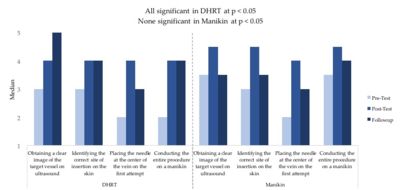Poster2 - 05: PROCEDURAL CONFIDENCE IS IMPROVED WHEN USING A DYNAMIC HAPTIC ROBOT COMPARED TO A STANDARD MANIKIN TRAINER
Cheyenne C Sonntag, MD1, Hong-En Chen, BS2, David F Pepley, MS2, David C Han, MD1, Jason Z Moore, PhD2, Scarlett R Miller, PhD2; 1Penn State Hershey Medical Center, 2Penn State University
Introduction: The limitations of manikin trainers for central venous catheterization (CVC) instruction have been well documented. To address this, a novel dynamic haptic robotic training (DHRT) system was developed and incorporated into our surgical residency curriculum. While the lasting impact of the DHRT has yet to be investigated, confidence of the learner, measured as self-efficacy, was monitored over a 12-month longitudinal study. The purpose was to compare CVC self-efficacy gains among residents trained using manikin and DHRT systems.
Methods: Nine surgical interns were randomly assigned to either DHRT (n=5) or manikin (n=4) systems at the beginning of their residency. All participated in a pretest on a manikin, then underwent three months of training in their assigned group, and then completed a posttest on a manikin. Self-efficacy ratings were collected at the time of the pretest and the posttest, as well as at eight months follow-up after each resident had CVC experience in the Surgical Intensive Care Unit. Friedman’s Tests were used to compare changes in self-efficacy ratings during the three treatment periods.
Results: Subjects who underwent DHRT demonstrated statistically significant improvements in their confidence in obtaining a clear image of the target vessel on ultrasound (p<0.023), identifying the correct site of insertion on the skin (p<0.018), placing the needle at the center of the vein on the first attempt (p<0.037), and conducting the entire procedure on a manikin (p<0.037). Interns who underwent training on the standard manikin showed no significant change in any of the self-efficacy parameters.
Conclusion: The self-efficacy surveys of individuals trained on the DHRT showed improved confidence with ultrasound imaging, site identification, and needle placement over the 12-month period while no significant change was observed in individuals trained on the manikin. While a prima facie argument can be made that procedural confidence matters, further studies assessing long-term technical skill retention studies using DHRT are warranted.
